KTM RC390 Review – Tested by Trevor Hedge
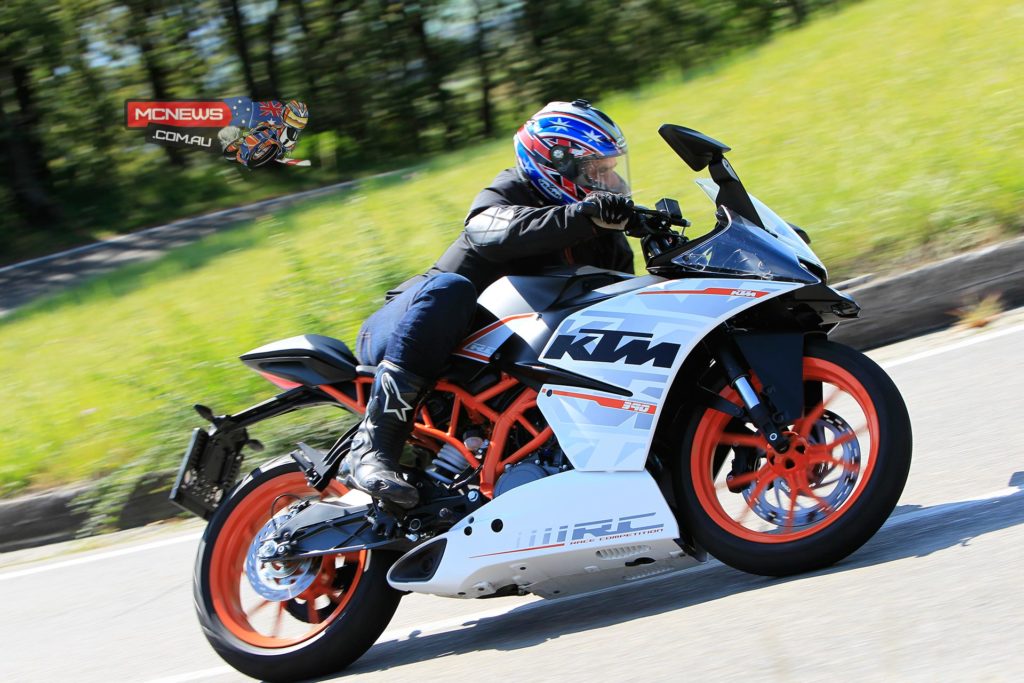
KTM have certainly been ramping up their street bike assault recently and the latest shot across the bows of the established street bike players to come from Mattighofen is the new KTM RC390. Based on the already successful 390 Duke, KTM have done a lot more than simply slap on a pair of fairings to come up with the mini sports bike that is the KTM RC (Race Competition) 390.
A steeper steering head angle, shorter trail and wheelbase measurements along with a more front oriented weight balance and increased lean angle capabilities, all focus the RC390 towards more sporting pursuits than its 390 Duke sibling.
Still, more than a nod has been given to the machine’s likelihood of being, for many buyers, their first ever motorcycle with a very user friendly persona that ensures the machine does not, like European machines of old, ride like a steel plank, prove problematic in the city or represent an ergonomic nightmare to the uninitiated.
The WP 43mm inverted front forks offer a generous 125mm of well controlled travel. There are no adjustments available but on launch the RC390 coped remarkably well across a rider range spanning close to 50kg from the lightest to heaviest rider. As one of the heavier riders, I was certainly impressed at the control from the forks during change of direction, while they also proved remarkably compliant on the pockmarked mountain roads we traversed during a 100km road loap above Maranello before we hit the track at the quite technical Autodromo di Modena in the afternoon.
The PDS rear shock utilises no linkage but instead mounts directly to the frame, a rear suspension design used on KTM enduro machines for decades. This experience has allowed WP and KTM to grace the RC390 with a very generous 150mm of travel, while retaining reasonable control throughout the stroke of the progressively wound spring when it comes time to have a go in the twisties. Only preload is adjustable and at the circuit we did dial on plenty of spring preload as we learned the circuit and got quicker as the afternoon wore on. There was only one quick flip-flop section where the track dropped away that the suspension got out of its comfort zone, requiring me to change my approach to that part of the circuit or the footpeg hit the deck and unloaded the rear enough for some slides that were more than a little out of my comfort zone, particularly when thousands of miles from home.
However, the suspension package is very impressive as a whole, and perhaps the leader in the class, but it is not out and out serious sportsbike specification, nor would you realistically expect as such from an affordable entry level machine. While up to the task of coping with a racetrack newcomer, accessories from the KTM Hard Equipment accessories catalogue, which, by the way, is borderline motorcycle pornography, or some other form of aftermarket suspension fettling would be needed for an experienced rider to get the best out of the machine. Rearsets (also available from KTM) would also be in order to allow for some really serious corner carving. That said, however, you are at the limit of the standard Metzeler M5 rubber at the circuit before the suspension or pegs are really limiting your progress, the edge grip of the 150/60ZR17 rear tyre struggling during maximum attack, while the front felt quite secure.
With the newcomer in mind the RC390 is fitted with switchable ABS as standard. It is not some low rent kit just so the word ABS looks good in a marketing catalogue, but a top of the line Bosch-KTM developed 9MB two-channel ABS system that is about as good as it gets. I was somewhat surprised with the amount of lever travel and effort required for maximum braking power but again. However, I believe it has been developed this way with the compliancy of the front fork and a newcomers possible ham-fisted control at the lever in mind. It is a good compromise well suited to the vast majority of RC390 buyers that will never see a racetrack. The four-piston radial front calliper is branded BYBRE, which basically means Brembo designed but produced under licence in India. Despite 20 minute track sessions the stoppers remained fade free and predictable at all times.
A surprisingly top-spec piece of equipment is the fully digital instrumentation on the RC390. It is not just the most fully-featured instrumentation ever fitted to a learner legal motorcycle, it almost surpasses just about everything else across all segments of motorcycling. If the myriad functions could be all switched through from the bar it really would be close to an outright market leader in functionality. Still, on a machine that has to operate in a very price conscious segment of the market it really is quite amazing the amount of effort KTM has put in to in this are of the machine. A gear position indicator, clear fuel and temperature readouts, programmable shift light, fully functional trip computer complete with instant economy and distance to empty all clearly visible under the integrated bar style tachometer.
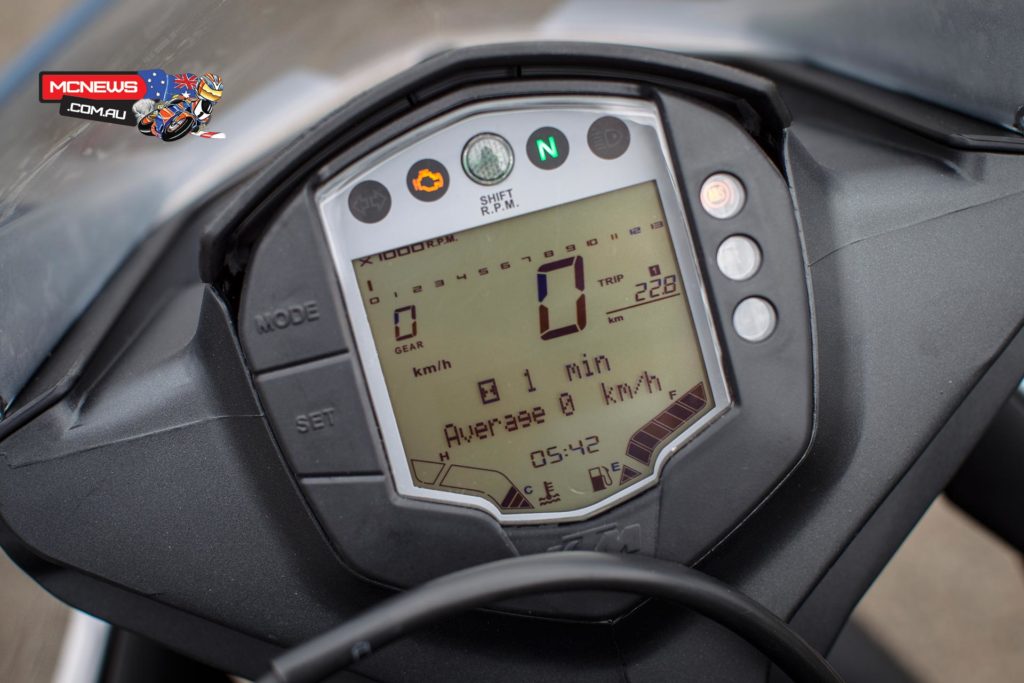
However, with only a ten-litre fuel tank that distance to empty readout will prove very handy indeed, as I would expect only a 200km maximum useable range on the urban commute.
Ergonomically the RC390 is very surprising, it seems to offer more room and comfort than its 390 Duke brethren, particularly for larger or taller riders, which really is a turn-up for the books where a naked machine is trumped in the comfort stakes by a more sports focussed sibling. The extra weight placed on the wrists, to help position more weight towards the front of the machine for increased front end grip, is quickly forgotten after some time in the saddle acclimatises you to the riding position. That weight on the wrists could put some people off at first, but it shouldn’t, it is not long before it is forgotten as the load is definitely not severe by any stretch, the rider simply turns on their core muscles to compensate.
KTM were one of the pioneers of competition specification four-stroke single-cylinder engines in the off-road market and have put the lessons learned across all those years into the design of the 375cc single that powers the RC390.
Single cylinder engines are generally renowned for two things; great low-mid rpm torque characteristics, but also some harshness at lower RPM if in the wrong gear. The RC390 certainly does have impressive bottom end oomph, thus the RC390 requires much lower RPM onboard for rapid getaways, in comparison to most of the established class peerage. The beauty of modern cylinder head design, a balancer shaft and the latest engine management systems and EFI smarts have eliminated any low-speed surging. If in a too tall a gear the RC390 will still grumble and chain snatch, but you really have to have been caught napping for this to happen.
Making a claimed 44hp at 9500rpm and 35Nm of torque at 7250rpm, the short-stroke engine has distinct advantages over what most would see as its main competitor, Kawasaki’s hugely successful Ninja 300. While the KTM claims only 10 per cent more power, it is the whopping 30 per cent more torque that really translates to much punchier street performance from the RC390 that carries right through quite smoothly to an 11,000rpm rev-limiter. At 100km/h the RC390 sits happily on 6000rpm and it is only when cruising above 120km/h that any small vibrations become evident through the bars. At the racetrack we could click sixth gear and just nudge 160km/h before having to get on the brakes for turn one. There would be a little bit more left to the patient top speed chaser but acceleration rates do tail off past 150km/h. 7500km service intervals are specified.
The learner segment is, perhaps, one of the most fashion conscious areas of the motorcycle market and this is something KTM clearly realises as the RC390 is full of very subtle design ideas that really help project the image of the machine as something quite special.
The lack of a rear suspension linkage has opened up space for KTM to hide the muffler up behind the engine out of immediate view, which really does help with the racey look of the machine. The way the exhaust outlet then snakes down to be tastefully crafted into the belly pan is quite brilliant, perhaps even more tastefully carried off than those top-spec red machines that come out of a factory in Bologna, just down the road from where we tested the RC390.
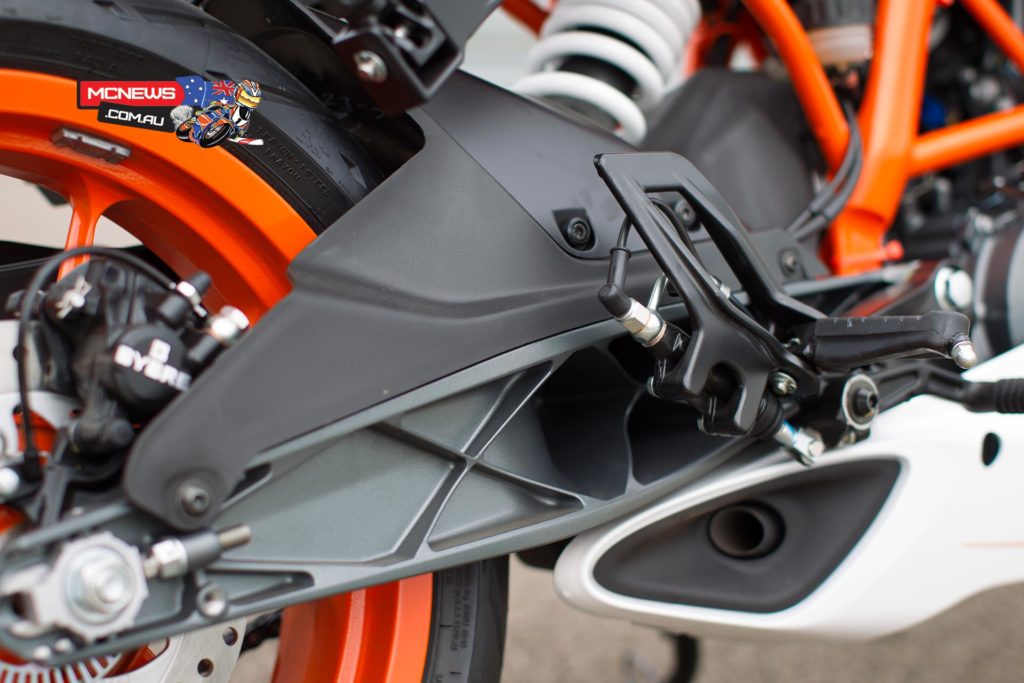
The more you look at the machine the more interesting aspects of the design hit home, from the cleverly integrated daytime LCD running lights, intricate swingarm, front indicators nestled inside the mirror stalks and the taillight that seems at one with the tail section of the motorcycle shows an attention to fine detail rarely seen in the finish of any motorcycle. And that’s before you even get to the ground breaking rear seat. The whole upper section of the tail unit is covered in high-density material sourced from Canada and finished to a look that resembles a matt-black traditional solo seat cowl. It not only is an absolute masterstroke of design, sure to be copied endlessly from here on in as designers/engineers around the world slap their foreheads in disgust at not already have brung this innovative approach to market themselves, but also proves fully functional. KTM’s design partners Kiska have done an amazing job with the RC390 and full credit to KTM management and beancounters for actually allowing these innovations through to the production model, rather than being cast off as too expensive to implement and never getting any further than clay model stage.
Lots of thought has already been put into the optional extras for the machine which include rear tail bags specifically designed to suit the RC390 in an expandable 10-30 litre format or a larger 24-36 litre tail unit, either of which will add plenty of real world practicality to the RC390.
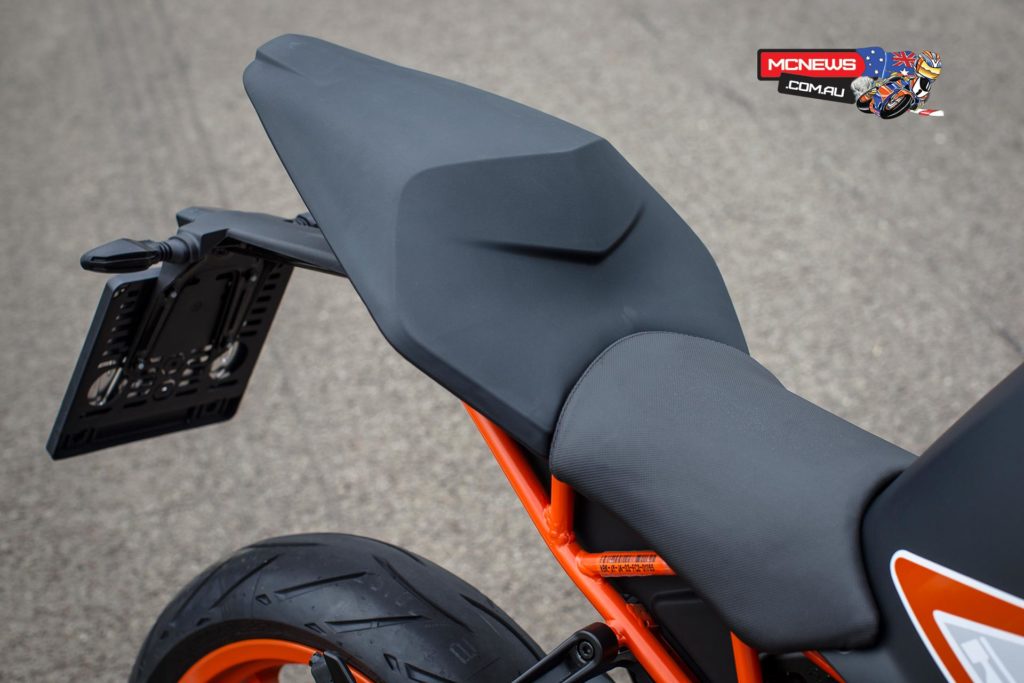
Sure, the lack of full suspension adjustment is certainly a worthwhile feature that is lacking, but, along with the non-adjustable levers, these are perhaps the only areas of the machine where any evidence of ‘built-to-a-price’ is exhibited. Of course, the fact that the machine remains affordable is largely thanks to the production of the machine being outsourced, under close Austrian supervision, to KTM’s Indian business partner, and 48 per cent shareholder, Bajaj Auto. But if the launch machines were anything to go by, the fact that the RC390 is Indian built should be of no concern to buyers, as from what I saw the general level of finish was quite brilliant.
KTM Australia is introducing the RC390 at $8295 with the first deliveries expected in November. While that price is certainly more expensive than the top selling Ninja 300R, and $1000 more than Honda’s more powerful CBR500R, the RC390 certainly brings a new flavour into the market, and one we think will prove very popular.
There could never be a clearer statement that KTM are now taking the road business very seriously than what the RC390 brings to the party. That KTM have chosen to go all-out in almost every design area in this affordable entry level machine makes me wonder just what they might have in store for us in the middle and upper capacity streetbike markets….
Please check out the video from the launch and also our comprehensive gallery of images highlighting the KTM RC390 further down the page.
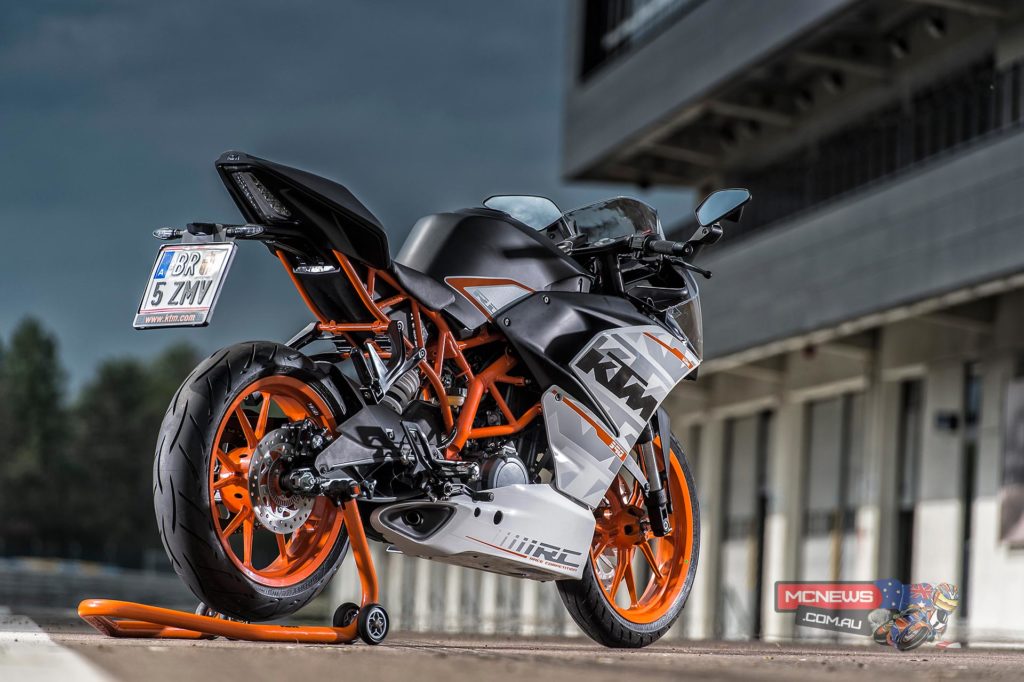
KTM RC390 Technical Specifications
- Engine – 375cc, single-cylinder, liquid-cooled, DOHC, 4-valve, wet sump
- Bore x Stroke – 89 x 60mm
- Claimed Power – 32kW (44hp) at 9500rpm
- Claimed Torque – 35Nm at 7250rpm
- Compression Ratio – 12.5:1
- Transmission – Six gears, wet clutch
- Induction – Bosch EFI with 46mm throttle body
- Frame – Steel trellis and steel sub-frame
- Forks – WP43mm inverted, non adjustable, 125mm travel
- Shock – WP PDS monoshock, progressive spring, preload only is adjustable, 150mm travel
- Front Brake – 300mm single disc, four-piston radial caliper, switchable ABS
- Rear Brake – 230mm disc, single piston calliper, ABS
- Rims – 3.0 x 17” (F) – 4.0 x 17” (R)
- Tyres – 110/70ZR17 (F), 150/60ZR17 (R)
- Steering Head Angle – 66.5 degrees
- Trail – 88mm
- Wheelbase – 1340 +/- 15mm
- Ground Clearance – 178.5mm
- Seat Height – 820mm
- Fuel Capacity – 10 litres
- Dry Weight – 147kg
- Warranty – Two years
- Available – November 2014 (TBC)
- RRP – $8295 + ORC























